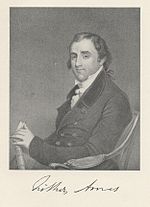Talk:History of Dedham, Massachusetts/draft
| Part of a series on the |
| History of Dedham |
|---|
 |
| Main article |
| Dedham, Massachusetts |
| By year |
|
| By topic |
The town of Dedham, Massachusetts (in the United States) has a long and storied history.
Pre-colonial
Before the
17th century
Dedham was "planted" in 1635,[2] and was formally settled as its own town in September 1636.[3]: 318 [4]: 547 The original tract of land granted to Dedham stretched for some 177 square miles,[4]: 547 (roughly 20 miles long and 10 miles wide)[2], extending from modern-day Roxbury and Dorchester to the Rhode Island state border.[2] Despite this, most people lived near 1.5 miles of the town center until 1682.[4]: 547
The town remained primarily
The town grew rapidly over the course of the 17th century. In 1648, the population was roughly 400 people; in 1700, the population was roughly 750.[3]: 326 Roughly 25% to 40% of the people of Dedham at any given time were new arrivals who did not live there during the previous decade, most of which were close relatives of Dedham's families.[3]: 322–323 (The data is distorted by the towns separated out of Dedham.[3]: 322–323 )
The town of Medfield, Massachusetts was split out of Dedham in 1649–51. Wrentham, Massachusetts was split out of Dedham in 1669–73.[3]: 322
Early lifestyle
This section is empty. You can help by adding to it. (December 2023) |
Early government
18th century
Dedham grew further in the 18th century. Its population reached 1,500 people around 1750, and almost 2,000 by 1775.[4]: 547
Three more towns were separated from Dedham in the 18th century with little opposition: Needham in 1711, Bellingham in 1719, and Walpole in 1724.[3]: 323 [4]: 548 By 1725, however, Dedham was much smaller than it had been, and people started questioning whether to break up the town further.[4]: 548
